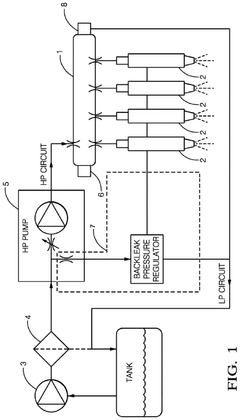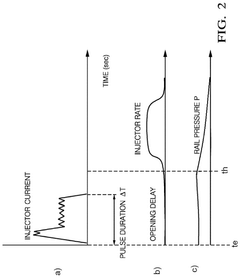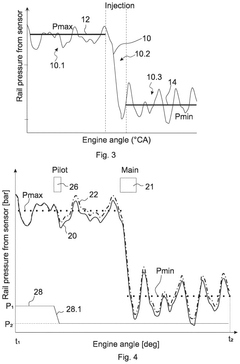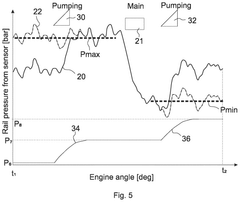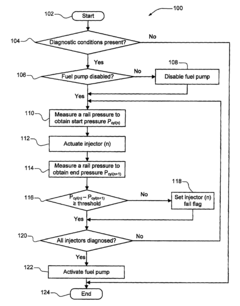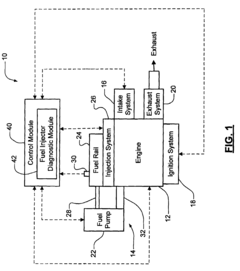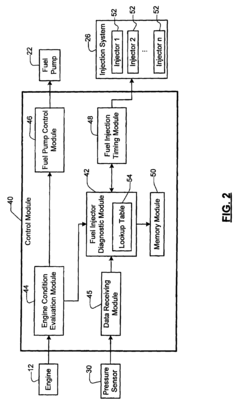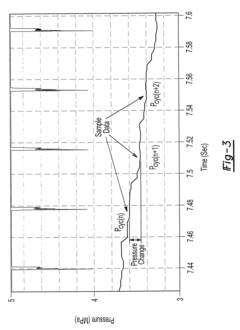K24 Engine Efficiency: Analysis of Fuel Injectors
JUL 3, 20259 MIN READ
Generate Your Research Report Instantly with AI Agent
Patsnap Eureka helps you evaluate technical feasibility & market potential.
K24 Engine Background
The K24 engine, developed by Honda Motor Company, is a 2.4-liter inline-four cylinder engine that has been widely used in various Honda and Acura vehicles since its introduction in the early 2000s. This engine is part of Honda's K-series engine family, known for its high performance, reliability, and fuel efficiency.
The K24 engine was designed to provide a balance between power and fuel economy, making it suitable for a range of applications from compact cars to mid-size SUVs. It features an aluminum block and cylinder head, which contributes to its lightweight design and improved thermal efficiency. The engine also incorporates Honda's i-VTEC (intelligent Variable Valve Timing and Lift Electronic Control) technology, which optimizes valve timing and lift for better performance across different engine speeds.
Over the years, the K24 engine has undergone several iterations and improvements. Early versions produced around 160 horsepower, while later models saw power outputs increase to over 200 horsepower in some applications. This evolution demonstrates Honda's commitment to continuous improvement and adaptation to changing market demands and regulatory requirements.
One of the key factors contributing to the K24 engine's efficiency is its fuel injection system. Initially equipped with multi-point fuel injection, later versions of the K24 engine adopted direct injection technology. This advancement allowed for more precise fuel delivery, improved atomization, and better combustion control, ultimately leading to enhanced fuel efficiency and reduced emissions.
The K24 engine has been utilized in a variety of Honda and Acura models, including the Honda Accord, CR-V, Element, and Acura TSX. Its versatility and reliability have made it a popular choice among consumers and a benchmark in its class. The engine's design also allows for relatively easy modifications, making it a favorite among automotive enthusiasts for performance upgrades.
As environmental concerns and fuel efficiency standards have become increasingly stringent, Honda has continued to refine the K24 engine. Recent iterations have focused on reducing friction, improving thermal management, and optimizing combustion processes. These efforts have resulted in engines that not only meet current emissions standards but also provide improved fuel economy without sacrificing performance.
The ongoing development of the K24 engine reflects broader trends in the automotive industry, including the push for greater efficiency, reduced environmental impact, and the integration of advanced technologies. As such, studying the evolution and efficiency of the K24 engine, particularly its fuel injection systems, provides valuable insights into the challenges and opportunities facing modern internal combustion engine design.
The K24 engine was designed to provide a balance between power and fuel economy, making it suitable for a range of applications from compact cars to mid-size SUVs. It features an aluminum block and cylinder head, which contributes to its lightweight design and improved thermal efficiency. The engine also incorporates Honda's i-VTEC (intelligent Variable Valve Timing and Lift Electronic Control) technology, which optimizes valve timing and lift for better performance across different engine speeds.
Over the years, the K24 engine has undergone several iterations and improvements. Early versions produced around 160 horsepower, while later models saw power outputs increase to over 200 horsepower in some applications. This evolution demonstrates Honda's commitment to continuous improvement and adaptation to changing market demands and regulatory requirements.
One of the key factors contributing to the K24 engine's efficiency is its fuel injection system. Initially equipped with multi-point fuel injection, later versions of the K24 engine adopted direct injection technology. This advancement allowed for more precise fuel delivery, improved atomization, and better combustion control, ultimately leading to enhanced fuel efficiency and reduced emissions.
The K24 engine has been utilized in a variety of Honda and Acura models, including the Honda Accord, CR-V, Element, and Acura TSX. Its versatility and reliability have made it a popular choice among consumers and a benchmark in its class. The engine's design also allows for relatively easy modifications, making it a favorite among automotive enthusiasts for performance upgrades.
As environmental concerns and fuel efficiency standards have become increasingly stringent, Honda has continued to refine the K24 engine. Recent iterations have focused on reducing friction, improving thermal management, and optimizing combustion processes. These efforts have resulted in engines that not only meet current emissions standards but also provide improved fuel economy without sacrificing performance.
The ongoing development of the K24 engine reflects broader trends in the automotive industry, including the push for greater efficiency, reduced environmental impact, and the integration of advanced technologies. As such, studying the evolution and efficiency of the K24 engine, particularly its fuel injection systems, provides valuable insights into the challenges and opportunities facing modern internal combustion engine design.
Market Demand Analysis
The market demand for efficient fuel injectors in K24 engines has been steadily increasing due to the growing emphasis on fuel economy and environmental regulations. As automotive manufacturers strive to meet stringent emission standards and improve overall engine performance, the demand for advanced fuel injection systems has surged. The K24 engine, known for its reliability and versatility, has become a popular choice in various vehicle models, further driving the need for optimized fuel injectors.
Consumer preferences have shifted towards vehicles that offer better fuel efficiency without compromising performance. This trend has created a significant market opportunity for fuel injector manufacturers to develop and supply innovative solutions for K24 engines. The automotive industry's focus on reducing carbon footprints and enhancing fuel economy has led to increased investments in research and development of fuel injection technologies.
The market for K24 engine fuel injectors is not limited to new vehicle production. There is also a substantial aftermarket segment, where vehicle owners seek to upgrade their existing engines with more efficient fuel injection systems. This dual-market approach has expanded the overall demand for advanced fuel injectors, creating opportunities for both OEM suppliers and aftermarket manufacturers.
Geographically, the demand for K24 engine fuel injectors is particularly strong in regions with strict emission regulations, such as North America, Europe, and parts of Asia. These markets have seen a faster adoption rate of advanced fuel injection technologies, driven by government mandates and consumer awareness of environmental issues.
The commercial vehicle sector has also contributed to the growing demand for efficient fuel injectors in K24 engines. Fleet operators and logistics companies are increasingly prioritizing fuel efficiency to reduce operating costs and meet sustainability goals. This has led to a rise in the adoption of K24 engines equipped with advanced fuel injection systems in light commercial vehicles and small trucks.
Looking ahead, the market demand for K24 engine fuel injectors is expected to continue its upward trajectory. Factors such as the ongoing electrification of vehicles, the development of hybrid powertrains, and the potential for alternative fuels are likely to shape the future of fuel injection technology. Manufacturers who can adapt their fuel injector designs to meet these evolving requirements will be well-positioned to capitalize on the growing market demand.
Consumer preferences have shifted towards vehicles that offer better fuel efficiency without compromising performance. This trend has created a significant market opportunity for fuel injector manufacturers to develop and supply innovative solutions for K24 engines. The automotive industry's focus on reducing carbon footprints and enhancing fuel economy has led to increased investments in research and development of fuel injection technologies.
The market for K24 engine fuel injectors is not limited to new vehicle production. There is also a substantial aftermarket segment, where vehicle owners seek to upgrade their existing engines with more efficient fuel injection systems. This dual-market approach has expanded the overall demand for advanced fuel injectors, creating opportunities for both OEM suppliers and aftermarket manufacturers.
Geographically, the demand for K24 engine fuel injectors is particularly strong in regions with strict emission regulations, such as North America, Europe, and parts of Asia. These markets have seen a faster adoption rate of advanced fuel injection technologies, driven by government mandates and consumer awareness of environmental issues.
The commercial vehicle sector has also contributed to the growing demand for efficient fuel injectors in K24 engines. Fleet operators and logistics companies are increasingly prioritizing fuel efficiency to reduce operating costs and meet sustainability goals. This has led to a rise in the adoption of K24 engines equipped with advanced fuel injection systems in light commercial vehicles and small trucks.
Looking ahead, the market demand for K24 engine fuel injectors is expected to continue its upward trajectory. Factors such as the ongoing electrification of vehicles, the development of hybrid powertrains, and the potential for alternative fuels are likely to shape the future of fuel injection technology. Manufacturers who can adapt their fuel injector designs to meet these evolving requirements will be well-positioned to capitalize on the growing market demand.
Fuel Injector Challenges
Fuel injectors play a crucial role in the efficiency and performance of K24 engines, yet they face several significant challenges. One of the primary issues is the formation of deposits on injector nozzles, which can lead to reduced fuel atomization and inconsistent spray patterns. These deposits, often resulting from fuel impurities and high operating temperatures, can significantly impair engine performance and increase emissions over time.
Another challenge is the need for precise fuel metering across a wide range of operating conditions. K24 engines require injectors capable of delivering accurate fuel quantities from idle to full throttle, and at varying engine speeds. This demand for adaptability puts considerable strain on injector design and manufacturing tolerances, as even minor deviations can result in suboptimal air-fuel ratios and reduced engine efficiency.
Durability is also a major concern for fuel injectors in K24 engines. The high-pressure environment and constant exposure to fuel and combustion byproducts can lead to wear and degradation of injector components. This wear can manifest as changes in spray patterns, reduced flow rates, or even complete injector failure, all of which negatively impact engine performance and longevity.
The increasing adoption of direct injection systems in K24 engines presents additional challenges for fuel injectors. These systems operate at much higher pressures than traditional port injection, requiring injectors to withstand greater mechanical stress while maintaining precision. The higher pressures also exacerbate the issue of deposit formation, as fuel is more likely to coke under these conditions.
Electromagnetic interference (EMI) is another hurdle that fuel injector designers must overcome. The rapid switching of injectors can generate electromagnetic noise, potentially disrupting other electronic systems in the vehicle. Shielding and proper wiring design are essential to mitigate these effects, but they add complexity and cost to the overall system.
As emissions regulations become more stringent, fuel injectors face the challenge of supporting increasingly lean combustion strategies. This requires even greater precision in fuel delivery and atomization to ensure complete combustion and minimize harmful emissions. Injectors must be capable of producing finer spray patterns and operating reliably under higher cylinder pressures associated with lean-burn technologies.
Lastly, the cost-effectiveness of fuel injectors remains an ongoing challenge. While advanced injector technologies can offer significant performance and efficiency gains, they must be balanced against manufacturing costs to remain viable for mass-market K24 engine applications. This necessitates continuous innovation in materials and production processes to deliver high-performance injectors at competitive price points.
Another challenge is the need for precise fuel metering across a wide range of operating conditions. K24 engines require injectors capable of delivering accurate fuel quantities from idle to full throttle, and at varying engine speeds. This demand for adaptability puts considerable strain on injector design and manufacturing tolerances, as even minor deviations can result in suboptimal air-fuel ratios and reduced engine efficiency.
Durability is also a major concern for fuel injectors in K24 engines. The high-pressure environment and constant exposure to fuel and combustion byproducts can lead to wear and degradation of injector components. This wear can manifest as changes in spray patterns, reduced flow rates, or even complete injector failure, all of which negatively impact engine performance and longevity.
The increasing adoption of direct injection systems in K24 engines presents additional challenges for fuel injectors. These systems operate at much higher pressures than traditional port injection, requiring injectors to withstand greater mechanical stress while maintaining precision. The higher pressures also exacerbate the issue of deposit formation, as fuel is more likely to coke under these conditions.
Electromagnetic interference (EMI) is another hurdle that fuel injector designers must overcome. The rapid switching of injectors can generate electromagnetic noise, potentially disrupting other electronic systems in the vehicle. Shielding and proper wiring design are essential to mitigate these effects, but they add complexity and cost to the overall system.
As emissions regulations become more stringent, fuel injectors face the challenge of supporting increasingly lean combustion strategies. This requires even greater precision in fuel delivery and atomization to ensure complete combustion and minimize harmful emissions. Injectors must be capable of producing finer spray patterns and operating reliably under higher cylinder pressures associated with lean-burn technologies.
Lastly, the cost-effectiveness of fuel injectors remains an ongoing challenge. While advanced injector technologies can offer significant performance and efficiency gains, they must be balanced against manufacturing costs to remain viable for mass-market K24 engine applications. This necessitates continuous innovation in materials and production processes to deliver high-performance injectors at competitive price points.
Current Injector Solutions
01 Optimization of fuel injection timing and duration
Improving fuel injector efficiency by optimizing the timing and duration of fuel injection. This involves precise control of injection events based on engine operating conditions, load, and speed. Advanced algorithms and sensors are used to determine the optimal injection parameters, resulting in improved combustion efficiency and reduced emissions.- Optimization of fuel injection timing: Improving fuel injector efficiency through precise control of injection timing. This involves adjusting the timing based on various engine parameters to ensure optimal fuel combustion and engine performance. Advanced control systems and algorithms are used to determine the best injection timing for different operating conditions.
- Enhanced fuel atomization techniques: Developing methods to improve fuel atomization for better combustion efficiency. This includes designing injector nozzles with optimized spray patterns and using high-pressure injection systems to create finer fuel droplets. Improved atomization leads to more complete combustion and reduced emissions.
- Integration of sensors and feedback systems: Incorporating advanced sensors and feedback systems to monitor and adjust fuel injection in real-time. These systems can detect changes in engine conditions, fuel quality, and environmental factors, allowing for dynamic adjustments to maintain optimal efficiency. Machine learning algorithms may be used to continuously improve injection strategies.
- Multi-stage injection strategies: Implementing multi-stage injection techniques to improve combustion efficiency and reduce emissions. This approach involves splitting the fuel injection into multiple smaller injections during each combustion cycle, allowing for better control of the combustion process and improved overall engine performance.
- Materials and manufacturing improvements: Developing new materials and manufacturing techniques for fuel injectors to enhance durability, precision, and efficiency. This includes using advanced alloys, coatings, and micro-manufacturing processes to create injectors with tighter tolerances, improved wear resistance, and better overall performance over the lifetime of the engine.
02 Enhanced fuel atomization and spray patterns
Developing fuel injectors with improved nozzle designs and spray patterns to enhance fuel atomization. This includes the use of multiple injection holes, optimized hole geometry, and advanced manufacturing techniques to create precise spray patterns. Better atomization leads to more efficient fuel-air mixing and combustion, resulting in improved engine performance and reduced fuel consumption.Expand Specific Solutions03 Integration of electronic control systems
Incorporating advanced electronic control systems to manage fuel injection processes. These systems use real-time data from various sensors to adjust injection parameters dynamically. They can compensate for variations in fuel quality, ambient conditions, and engine wear, ensuring optimal fuel efficiency across a wide range of operating conditions.Expand Specific Solutions04 High-pressure fuel injection systems
Developing high-pressure fuel injection systems to improve fuel atomization and combustion efficiency. These systems operate at significantly higher pressures than conventional injectors, allowing for finer fuel droplets and more precise control over the injection process. This results in more complete combustion, reduced emissions, and improved fuel economy.Expand Specific Solutions05 Smart diagnostics and self-calibration features
Implementing smart diagnostic and self-calibration features in fuel injection systems. These features allow the system to monitor its own performance, detect potential issues, and make automatic adjustments to maintain optimal efficiency. This includes compensating for injector wear, fuel quality variations, and changes in environmental conditions, ensuring consistent performance over the life of the engine.Expand Specific Solutions
Key Industry Players
The K24 Engine Efficiency and Fuel Injector market is in a mature stage, with established players like Robert Bosch GmbH, Delphi Technologies, and DENSO Corp. leading the field. The global automotive fuel injector market size is projected to reach $102.56 billion by 2027, growing at a CAGR of 6.3% from 2020 to 2027. Technological maturity is high, with companies like Toyota, GM, and Ford continuously innovating to improve engine efficiency and meet stringent emission standards. Major automakers such as Volkswagen, Hyundai, and Mazda are also investing heavily in research and development to enhance fuel injection systems, focusing on precision, durability, and compatibility with alternative fuels.
Robert Bosch GmbH
Technical Solution: Bosch has developed advanced fuel injection systems for the K24 engine, focusing on high-pressure direct injection technology. Their latest system utilizes piezoelectric injectors capable of multiple injections per combustion cycle, with pressures up to 350 bar[1]. This allows for precise fuel atomization and distribution, resulting in improved combustion efficiency. Bosch's system also incorporates adaptive injection timing and duration based on real-time engine parameters, optimizing fuel delivery across various operating conditions[3]. The company has integrated their injection system with advanced engine control units (ECUs) that use sophisticated algorithms to continuously adjust injection strategies, further enhancing fuel economy and reducing emissions[5].
Strengths: Precise fuel control, adaptability to various engine conditions, and integration with advanced ECUs. Weaknesses: Higher cost compared to conventional systems, and potential complexity in maintenance.
GM Global Technology Operations LLC
Technical Solution: GM has developed a proprietary fuel injection system for the K24 engine, focusing on variable-pressure direct injection technology. Their system employs electronically controlled injectors capable of operating at pressures ranging from 100 to 300 bar, allowing for optimal fuel delivery across different engine loads[2]. GM's approach includes a dual-mode injection strategy, switching between single and multiple injections per cycle based on engine speed and load. This system is integrated with GM's latest engine management software, which utilizes machine learning algorithms to continuously optimize injection patterns for improved efficiency[4]. Additionally, GM has implemented a unique injector cooling system to maintain consistent performance under high-load conditions, enhancing overall engine reliability and longevity[6].
Strengths: Flexible injection pressure range, adaptive injection strategies, and advanced cooling system. Weaknesses: Potential for increased system complexity and higher production costs.
Innovative Injector Tech
Improved pressure drop analysis strategy
PatentPendingUS20250137416A1
Innovation
- A method that processes rail pressure data to cancel artefacts such as external injector events and pumping events, providing corrected rail pressure data for improved accuracy in PDA strategies.
Fuel injector diagnostic system and method for direct injection engine
PatentActiveUS7980120B2
Innovation
- A fuel injector diagnostic system comprising a fuel pump control module, a pressure sensor, and a diagnostic module that measures fuel rail pressures before and after an injection event while the engine is running, allowing for fault diagnosis based on pressure differences, even at high engine loads and idling conditions.
Emissions Regulations
Emissions regulations have become increasingly stringent in recent years, significantly impacting the development and implementation of fuel injection systems in automotive engines, including the K24 engine. These regulations aim to reduce harmful emissions and improve air quality, driving manufacturers to innovate and optimize their fuel injection technologies.
The United States Environmental Protection Agency (EPA) and the European Union's Euro emissions standards are at the forefront of global emissions regulations. These standards set limits on various pollutants, including carbon monoxide (CO), nitrogen oxides (NOx), and particulate matter (PM). As these standards become more stringent, fuel injectors play a crucial role in meeting these requirements while maintaining engine performance and efficiency.
For the K24 engine, compliance with emissions regulations has necessitated advancements in fuel injector design and operation. Direct injection systems have become increasingly prevalent, allowing for more precise control over fuel delivery and combustion. These systems enable better fuel atomization, resulting in more complete combustion and reduced emissions.
The introduction of multiple injection events per combustion cycle has also been a key development in meeting emissions targets. This technique allows for pre-injection, main injection, and post-injection events, optimizing the combustion process and reducing the formation of pollutants. Additionally, higher injection pressures have been implemented to further improve fuel atomization and mixing, leading to more efficient combustion and lower emissions.
Emissions regulations have also driven the adoption of advanced engine control strategies. These include closed-loop control systems that continuously monitor and adjust fuel injection parameters based on real-time sensor data. Such systems enable dynamic optimization of the air-fuel ratio, ignition timing, and other factors to minimize emissions across various operating conditions.
The integration of exhaust gas recirculation (EGR) systems with fuel injection technology has been another key area of development. EGR helps reduce NOx emissions by lowering combustion temperatures, requiring fuel injectors to adapt to changes in intake charge composition and maintain optimal performance.
As emissions standards continue to evolve, fuel injector technology for the K24 engine and similar powerplants must advance accordingly. Future regulations are expected to focus on further reductions in greenhouse gas emissions, particularly CO2. This will likely drive the development of even more precise and efficient fuel injection systems, potentially incorporating new materials and manufacturing techniques to achieve higher injection pressures and finer atomization.
The United States Environmental Protection Agency (EPA) and the European Union's Euro emissions standards are at the forefront of global emissions regulations. These standards set limits on various pollutants, including carbon monoxide (CO), nitrogen oxides (NOx), and particulate matter (PM). As these standards become more stringent, fuel injectors play a crucial role in meeting these requirements while maintaining engine performance and efficiency.
For the K24 engine, compliance with emissions regulations has necessitated advancements in fuel injector design and operation. Direct injection systems have become increasingly prevalent, allowing for more precise control over fuel delivery and combustion. These systems enable better fuel atomization, resulting in more complete combustion and reduced emissions.
The introduction of multiple injection events per combustion cycle has also been a key development in meeting emissions targets. This technique allows for pre-injection, main injection, and post-injection events, optimizing the combustion process and reducing the formation of pollutants. Additionally, higher injection pressures have been implemented to further improve fuel atomization and mixing, leading to more efficient combustion and lower emissions.
Emissions regulations have also driven the adoption of advanced engine control strategies. These include closed-loop control systems that continuously monitor and adjust fuel injection parameters based on real-time sensor data. Such systems enable dynamic optimization of the air-fuel ratio, ignition timing, and other factors to minimize emissions across various operating conditions.
The integration of exhaust gas recirculation (EGR) systems with fuel injection technology has been another key area of development. EGR helps reduce NOx emissions by lowering combustion temperatures, requiring fuel injectors to adapt to changes in intake charge composition and maintain optimal performance.
As emissions standards continue to evolve, fuel injector technology for the K24 engine and similar powerplants must advance accordingly. Future regulations are expected to focus on further reductions in greenhouse gas emissions, particularly CO2. This will likely drive the development of even more precise and efficient fuel injection systems, potentially incorporating new materials and manufacturing techniques to achieve higher injection pressures and finer atomization.
Cost-Benefit Analysis
The cost-benefit analysis of implementing advanced fuel injectors in the K24 engine reveals a complex interplay of financial considerations and performance improvements. Initial investment costs for upgrading to high-precision fuel injectors are substantial, encompassing not only the components themselves but also the necessary modifications to the engine management system and potential retooling of production lines. These upfront expenses can be significant, potentially ranging from $500 to $2000 per engine, depending on the sophistication of the chosen injector technology.
However, the long-term benefits of this investment are compelling. Improved fuel atomization and precise fuel delivery lead to more efficient combustion, resulting in a potential fuel economy increase of 3-5%. For a vehicle with an average annual mileage of 12,000 miles and a fuel efficiency of 25 mpg, this could translate to savings of 14-24 gallons of fuel per year. At current fuel prices, this represents an annual cost reduction of $40-$70 per vehicle for the end-user.
From an environmental perspective, the reduced fuel consumption directly correlates to lower CO2 emissions, potentially decreasing by 132-220 kg per vehicle annually. This aligns with increasingly stringent emissions regulations and can enhance the manufacturer's environmental credentials, potentially leading to marketing advantages and increased sales in environmentally conscious markets.
The improved combustion efficiency also contributes to enhanced engine performance, with potential increases in horsepower and torque by 2-4%. This performance boost, while modest, can be a significant selling point in competitive markets, potentially justifying a higher retail price for vehicles equipped with these advanced injectors.
Maintenance costs present a mixed picture. While the advanced injectors may have a longer lifespan due to improved design and materials, their complexity could lead to higher replacement costs when failures do occur. However, the overall reduction in carbon deposits and more consistent engine performance could lead to reduced general maintenance needs, potentially offsetting the higher component costs.
When considering production at scale, the cost-benefit ratio improves significantly. Bulk purchasing of components and streamlined integration into the manufacturing process can substantially reduce per-unit costs. Additionally, the potential for reduced warranty claims due to improved engine reliability should be factored into the long-term financial calculations.
In conclusion, while the initial investment in advanced fuel injectors for the K24 engine is substantial, the long-term benefits in terms of fuel efficiency, environmental impact, and performance improvements present a compelling case for implementation. The break-even point for this investment would likely occur within 3-5 years of vehicle operation, depending on usage patterns and fuel prices, making it an attractive proposition for both manufacturers and consumers in the current market landscape.
However, the long-term benefits of this investment are compelling. Improved fuel atomization and precise fuel delivery lead to more efficient combustion, resulting in a potential fuel economy increase of 3-5%. For a vehicle with an average annual mileage of 12,000 miles and a fuel efficiency of 25 mpg, this could translate to savings of 14-24 gallons of fuel per year. At current fuel prices, this represents an annual cost reduction of $40-$70 per vehicle for the end-user.
From an environmental perspective, the reduced fuel consumption directly correlates to lower CO2 emissions, potentially decreasing by 132-220 kg per vehicle annually. This aligns with increasingly stringent emissions regulations and can enhance the manufacturer's environmental credentials, potentially leading to marketing advantages and increased sales in environmentally conscious markets.
The improved combustion efficiency also contributes to enhanced engine performance, with potential increases in horsepower and torque by 2-4%. This performance boost, while modest, can be a significant selling point in competitive markets, potentially justifying a higher retail price for vehicles equipped with these advanced injectors.
Maintenance costs present a mixed picture. While the advanced injectors may have a longer lifespan due to improved design and materials, their complexity could lead to higher replacement costs when failures do occur. However, the overall reduction in carbon deposits and more consistent engine performance could lead to reduced general maintenance needs, potentially offsetting the higher component costs.
When considering production at scale, the cost-benefit ratio improves significantly. Bulk purchasing of components and streamlined integration into the manufacturing process can substantially reduce per-unit costs. Additionally, the potential for reduced warranty claims due to improved engine reliability should be factored into the long-term financial calculations.
In conclusion, while the initial investment in advanced fuel injectors for the K24 engine is substantial, the long-term benefits in terms of fuel efficiency, environmental impact, and performance improvements present a compelling case for implementation. The break-even point for this investment would likely occur within 3-5 years of vehicle operation, depending on usage patterns and fuel prices, making it an attractive proposition for both manufacturers and consumers in the current market landscape.
Unlock deeper insights with Patsnap Eureka Quick Research — get a full tech report to explore trends and direct your research. Try now!
Generate Your Research Report Instantly with AI Agent
Supercharge your innovation with Patsnap Eureka AI Agent Platform!
